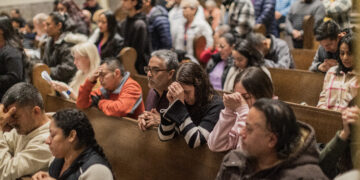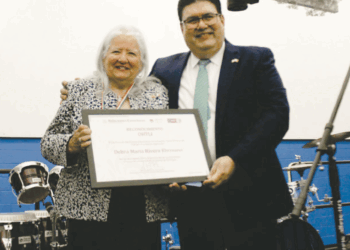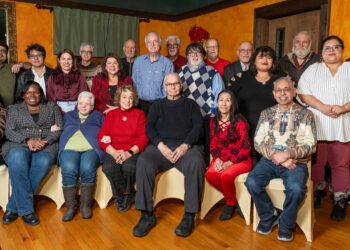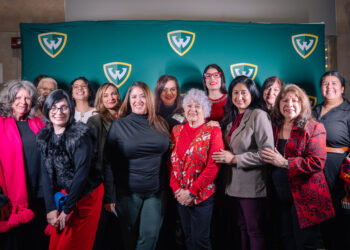On Saturday, May 20, the Michigan Regional Council of Carpenters and Millwrights (MRCC) hosted their first Spring Hiring Combine, an event to scout talent that took place at the Union Carpenters and Millwrights Skilled Training Center, a state-of-the-art, 147,000-square-foot training facility on Detroit’s west side.
While some of the potential recruits had carpentry skills and experience, it wasn’t a requirement to attend the event. The recruits were there to showcase their abilities in carpentry and millwrights by performing various drills in front of 30 contractors looking to hire. The MRCC hosted over 300 potential candidates looking for an opportunity to obtain unionized carpenter and millwright work.
The MRCC relocated to their new facility about one year ago, and has made a strong effort to recruit Southwest Detroiters; however, there has been some pushback from some of the local schools and the MRCC is trying to understand why? Juan Ortiz, a business representative for the MRCC, and the only bilingual, Spanish-speaking agent in Southeast Michigan, has led the charge to try and inform the community of the union.

Ortiz began his career 25 years ago as a carpenter and has been instrumental in hiring Latino staff members at the training facility. “The need for (Latin union members) was there since I was in the field,” Ortiz stated. “I made it clear that we needed a bilingual secretary and a bilingual teacher, and now we have both.”
Tom Lutz, Executive Secretary-Treasurer (Principal Officer of the MRCC), got a chance to explain why an event like the combine is important to have for the union.
“Tradespeople build the physical world we live in, no matter how digital we become, and you can’t find that person on a resume,” Lutz said. “So we created this (event) to give them the opportunity to share with contractors looking to hire people with these skills and show these potential employers how much they belong in the skilled trades.”
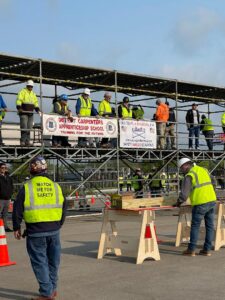
Lutz went on to explain why he believes there’s a lack of Latino students at the facility and the struggle to connect with the community.
“The construction industry, in essence, is probably 90% male, and probably 70% white, and we’re trying to change that. Sometimes those early stage hurdles are language (barriers), but we’re trying to go to them by having business agents who speak Spanish, having men and women of color representing us,” Lutz said. “We’re trying to change and to open doors to provide opportunities to people in underserved communities, and the (Latino) community is definitely underserved in the construction market.”
Lutz and Ortiz both highlighted some of the benefits the MRCC provides. They offer a pay-as-you-learn apprentice program where students come to class one day every two weeks and get paid while they’re in school. Other benefits of being a part of the union are having a regular work schedule, and being able to qualify for benefits. The education learned at the facility also is used towards college credits, giving students the ability to further their career paths. No experience is needed to apply to the program.
For many the skilled trade field is a family tradition that is passed on from one generation to the next. Arnulfo “Arnie” Dealba, who serves as an instructor at the facility, was taught the carpentry trade by his father, but never thought a program like this would have such a huge impact on his life.
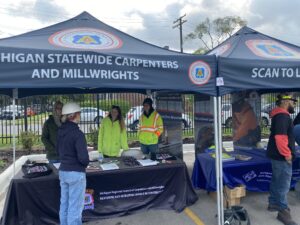
“I was getting in trouble, my plan when I moved (to Michigan from California) was to make money and move back,” Dealba states. “When I got here I started making money, I realized if I moved back I was going to go back to my same habits, it was time to grow up.”
Dealba speaks highly of being in a union. “I know a lot of people who aren’t in the union, and they work from sunrise to sundown and are only making $120 for a 12-hour shift.” He says that unionized workers have more protection and don’t get taken advantage of like some non-union workers.
As the cost of a four-year college tuition continues to dramatically rise and there is great demand for carpenters and millwrights, a trade school seems to be more of an option for anyone coming out of high school or looking for a fresh start in their career. “If you have the desire and the motivation to do it, it’s not too hard,” Ortiz said.
If you missed the combine, visit www.buildmifuture.com for more information about becoming an apprentice.
Photos by: Ron Maracle, Eric Guzman, y Steve Purchase
Gran evento "Hiring Combine" para carpinteros y molineros latinos
El sábado 20 de mayo, el Consejo Regional de Carpinteros y Molineros de Michigan (MRCC por sus siglas en inglés) organizó su primer Hiring Combine de primavera, un evento para buscar talentos que tuvo lugar en el Union Carpenters and Millwrights Skilled Training Center, un centro de capacitación de última generación de 147,000 pies cuadrados en el lado oeste de Detroit.
Si bien algunos de los reclutas potenciales tenían habilidades y experiencia en carpintería, no era un requisito para asistir al evento. Los reclutas estaban allí para mostrar sus habilidades de carpintería y construcción de molinos, realizando varios ejercicios frente a 30 contratistas que buscaban personal. El MRCC recibió a más de 300 candidatos, que buscaban la oportunidad de obtener un trabajo sindicalizado de carpintero o mecánico industrial.
El MRCC se trasladó a sus nuevas instalaciones hace aproximadamente un año y ha hecho un gran esfuerzo para reclutar a los habitantes del suroeste de Detroit; sin embargo, ha habido cierto rechazo por parte de algunas de las escuelas locales y el MRCC está tratando de entender el por qué Juan Ortiz, un representante comercial de MRCC y el único agente bilingüe de habla hispana en el sureste de Michigan, ha encabezado la tarea de informar a la comunidad sobre el sindicato.

Ortiz comenzó su carrera hace 25 años como carpintero y ha sido fundamental en la contratación de personal latino en el centro de capacitación. “La necesidad de miembros latinos ha estado allí desde que yo estaba en ese campo”, dijo Ortiz. “Dejé claro que necesitábamos una secretaria bilingüe y un maestro bilingüe, y ahora los tenemos a ambos”.
Tom Lutz, Secretario Ejecutivo-Tesorero (director oficial del MRCC), tuvo la oportunidad de explicar por qué es importante tener un evento como éste para el sindicato.
“Los comerciantes construyen el mundo físico en el que vivimos, sin importar cuán digitales nos volvamos, y no puedes encontrar a esa persona en un currículum”, dijo Lutz. “Así que creamos este evento para darles la oportunidad de compartir con los contratistas, que están buscando a personas con estas habilidades y mostrarles a estos posibles empleadores cuánto conocen estas personas sobre estos oficios calificados”.

Lutz continuó explicando por qué se cree que hay una falta de estudiantes latinos en las instalaciones y la lucha que se tiene por conectarse con la comunidad.
“La industria de la construcción, en esencia, es probablemente 90 % masculina y probablemente 70 % blanca, y estamos tratando de cambiar eso. A veces, una las barreras de la etapa inicial es el idioma, pero estamos tratando de superarlas teniendo agentes comerciales que hablen español, con hombres y mujeres morenos que nos representen”, dijo Lutz. “Estamos tratando de cambiar y abrir las puertas a las personas de las comunidades desatendidas, y la comunidad (latina) definitivamente está desatendida en el mercado de la construcción”.
Lutz y Ortiz destacaron algunos de los beneficios que brinda el MRCC, al ofrecer un programa de aprendizaje becado, en el que los estudiantes vienen a clase un día cada dos semanas y se les paga mientras estén en la escuela. Otro beneficio de ser parte del sindicato es tener un horario de trabajo regular y poder calificar para las diferentes prestaciones. La educación que se brinda en las instalaciones puede convertirse en créditos universitarios, lo que brinda a los estudiantes la posibilidad de avanzar en sus carreras profesionales. No se necesita experiencia para aplicar al programa.
Para muchos, el campo del comercio especializado es una tradición familiar que se transmite de generación en generación. Arnulfo “Arnie” Dealba, quien se desempeña como instructor, aprendió el oficio de carpintero de su padre, pero nunca pensó que un programa como este tendría un impacto tan grande en su vida.

“Me estaba metiendo en problemas, mi plan cuando me mudé (a Michigan desde California) era ganar dinero y regresarme… cuando llegué aquí comencé a ganar dinero y me di cuenta de que si regresaba volvería a los mismos hábitos, era hora de crecer” afirma Dealba. Quien habla muy bien de estar en un sindicato. “Conozco a muchas personas que no están en el sindicato, trabajan desde el amanecer hasta el anochecer y solo ganan $120 por un turno de 12 horas” y afirma que los trabajadores sindicalizados tienen más protección y no se aprovechan de ellos como de algunos trabajadores no sindicalizados.
Dado que el costo de la matrícula universitaria de cuatro años continúa aumentando drásticamente y existe una gran demanda de carpinteros y constructores de molinos, una escuela especializada parece ser una opción más adecuada para cualquiera que termine la escuela secundaria o busque un nuevo comienzo en su carrera. “Si tienes el deseo y la motivación para hacerlo, no es demasiado difícil”, dijo Ortiz.
Si se perdió el evento, por favor visite www.buildmifuture.com para obtener más información sobre el proceso de inscripción.
Fotos por: Ron Maracle, Eric Guzman, y Steve Purchase
















